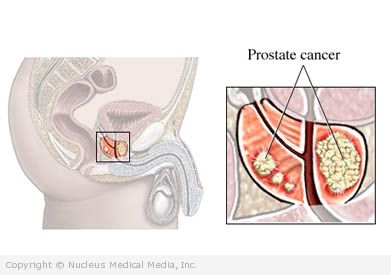Prostate biopsy
(Transrectal Biopsy; Transurethral Biopsy; Transperineal Biopsy)
Prostate biopsy – Definition
A prostate biopsy is the removal of a small amount of tissue from the prostate gland. The tissue is examined to determine whether there is cancer.
Prostate biopsy – Reasons for Procedure
This is usually done as a result of an abnormality found by:
- Digital rectal exam
- Prostate specific antigen blood test
A prostate biopsy is the only way to determine the presence of cancer cells.
Prostate biopsy – Possible Complications
Complications are rare, but no procedure is completely free of risk. If you are planning to have a prostate biopsy, your doctor will review a list of possible complications, which may include:
- Infection
- Bruising or prolonged bleeding from the rectum or in urine or semen
- Difficulty urinating
Factors that may increase the risk of complications include:
- Smoking
- History of bleeding disorders or easy bruising
- Use of any prescriptions, over-the-counter medicines, or herbal supplements
- Sensitivity or allergy to latex, medicines, or anesthesia
Be sure to discuss these risks with your doctor before the procedure.
Prostate biopsy – What to Expect
Prior to Procedure
You may be asked to do the following:
- Talk to your doctor about your medicines. You may be asked to stop taking some medicines up to one week before the procedure, like:
- Anti-inflammatory drugs (eg, aspirin)
- Blood thinners, such as clopidogrel (Plavix) or warfarin (Coumadin)
Begin taking an antibiotic if advised by your doctor.
Use an enema several hours before the procedure.
If you will be getting general anesthesia, do not eat or drink anything after midnight.
Prostate biopsy – Anesthesia
This depends on the method that your doctor uses:
- Transurethral biopsy and perineal biopsy:
- General anesthesia — blocks pain and keeps you asleep through the surgery, given through an IV in your hand or arm
- Local anesthesia — just the area that is being operated on is numbed, given as an injection and may also be given with a sedative
- Transrectal prostate biopsy — local anesthesia
Prostate biopsy – Description of the Procedure
Your doctor will use one of the following methods to do the biopsy:
- Transrectal biopsy (most common method) — Your doctor will insert a small ultrasound device into the rectum. This device will emit sound waves to produce an image of the prostate. These images will help guide placement of the needle. Your doctor will then insert the needle through the wall of your rectum and into the prostate gland.
- Transurethral biopsy — Your doctor will insert a lighted flexible tube through the penis into the urethra. The urethra carries urine from the bladder. Your doctor will get the biopsy with a cutting loop that is passed through the flexible tube.
- Perineal biopsy — Your doctor will make a small incision in the perineum. The perineum is the area between the scrotum and the rectum. The doctor will insert a small needle into the prostate gland to get the biopsy.
Prostate biopsy – How Long Will It Take?
About 30 minutes
Prostate biopsy – Will It Hurt?
You may have discomfort and soreness at the biopsy site.
Prostate biopsy – Postoperative Care
When you return home after the procedure, do the following to help ensure a smooth recovery:
- Stay hydrated. Drink plenty of fluids for the next few days.
- Avoid strenuous activity the day and evening of the procedure.
- Keep in mind that you may see blood in your urine, stool, or ejaculate for several days.
- Ask your doctor when you can resume taking your blood-thinning medicine.
- Ask your doctor about when it is safe to shower, bathe, or soak in water.
- Be sure to follow your doctor’s instructions.
Once the sample is taken, it will be sent to a pathologist. This doctor will analyze the sample for cancer. If cancer is present, your doctor will work with you to develop a treatment plan.
Prostate biopsy – Call Your Doctor
After arriving home, contact your doctor if any of the following occurs:
- Inability to urinate
- Blood in the urine more than 2-3 days post-biopsy
- Signs of infection, including fever and chills
- Pain that you cannot control with the medicines you have been given
- Pain, burning, urgency, or frequency of urination
- Cough, shortness of breath, or chest pain
- Persistent rectal bleeding or scant rectal bleeding that lasts more than 2-3 days after the biopsy
In case of an emergency, call for medical help right away.

